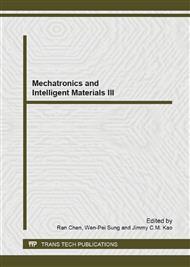[1]
Ke Shaoying, Shi Hongling and Liu Donglian. Antimony pollution and its toxic effects and bioavailability . Chemistry World, Vol. 46 No.6 (2005), pp.382-384.
Google Scholar
[2]
Zhang Daoyong, Pan Xiangliang and Mu Guijin. Pollution of water, soil environment, Antimony(Sb) and its eco-toxicological effects on plant and microbial research progress. Application and Environmental Biology, Vol. 16 No.6 (2010), pp.891-894.
Google Scholar
[3]
GB/T5750-2006 " Standard examination methods for drinking water ".
Google Scholar
[4]
Translation of Shenzhen Water (Group) Co., Ltd. Drinking water quality standards (WHO) Second edition, Beijing: People's Health Publishing House, (2003), p.109.
Google Scholar
[5]
Wei Bin, Wang Yang and Ren Cong. Graphite furnace atomic absorption method of Antimony determination in drinking water. Practical Preventive Medicine, Vol. 16 No.2 (2009), pp.554-556.
Google Scholar
[6]
PerkinElmer Inc., USA. The TH GA Graphite Furnace-Techniques and Recommended Conditions.
Google Scholar
[7]
Shao Jianfeng. Atomic absorption graphite furnace method for the determination of Antimony in drinking water . China Water & Wastewater, Vol.18 (2002), pp.84-85.
Google Scholar
[8]
Wu Xianfen, Liu Guixia. Graphite furnace atomic absorption spectrometry detects water Antimony . Water Purification Technology, Vol. 66 No.4 (1998), pp.21-23.
Google Scholar
[9]
Li Hongyun, Tian Haiyan and Li Mingyan. Hydride generation atomic fluorescence spectrophotometric simultaneous determination of Arsenic and Antimony in drinking water . Chinese Journal of Health Laboratory, Vol. 20 No.10 (2010), pp.2437-2438.
Google Scholar
[10]
Xu Guang. Research for Hydride generation-atomic fluorescence spectrometry method of trace Antimony determination . Liaoning Urban and Rural Environmental Science and Technology, Vol. 21 No.2 (2001), pp.26-28.
Google Scholar
[11]
Yang Jingde. Hydride generation atomic fluorescence spectrometry determination of trace Antimony . Chemical Engineering and equipment, No.8 (2010), pp.188-189.
Google Scholar
[12]
Zhu Li and Liu Yuting. L-cysteine as a reducing agent - hydride generation - atomic fluorescence spectrometry determination of Antimony in drinking water. Spectroscopy Laboratory, Vol. 25 No.5 (2008), pp.1023-1026.
Google Scholar
[13]
Li Jiaxue. Hydride generation-atomic fluorescence spectrometry determination of Arsenic and Antimony in drinking water . Career and Health , Vol. 25 No.23 (2009), pp.2518-2519.
Google Scholar
[14]
Pan Leiming, Yang Lin and Zhou Kan. Inductively coupled plasma mass spectrometry determination of Antimony content. Food Science and Technology, Vol. 36 No.122 (2011), pp.306-309.
Google Scholar
[15]
Gan Jie, Xu Jing and Luo Yueping . ICP-MS method for determination of surface waters of 18 metal elements. Environmental Monitoring Management and Technology, Vol. 22 No.5 (2010), pp.36-38.
Google Scholar
[16]
Xiao qiangguo, Hu Bin, Jiang Zucheng. Co-precipitation the enrichment / suspension injection electrothermal vaporization plasma mass spectrometry. The learned journal of Nanchang University, No.30 (2006).
Google Scholar
[17]
Ji Haibing, Zhao Chengyi and He Mengchang . Hydride generation combined with inductively coupled plasma atomic emission spectrometry. TESTING a Chemical Analysis , Vol. 40 No.7 (2004), pp.410-412.
Google Scholar


